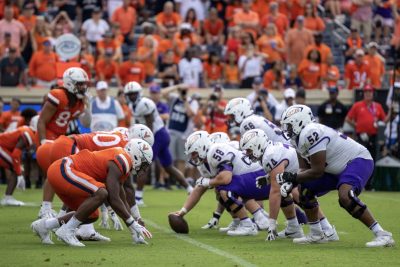5 Things we Learned About Virginia’s Football Team on Saturday
By Jerry Ratcliffe
One of the most disappointing aspects of Virginia’s loss to JMU on Saturday was how the Cavaliers failed to respond after an hour-long break for a thunderstorm.
While the visiting Dukes came out strong and quickly erased an 11-point deficit over the final 12 minutes, UVA was simply awful on both sides of the football and lost 36-35 in a stadium where the Wahoos were nearly unbeatable for the last few years of the Bronco Mendenhall era.
Here are 5 things we learned about Virginia in Saturday’s game:
1. Anthony Colandrea is the real deal. I will be the first to admit that I was skeptical about what the true freshman from St. Pete, Fla., was capable of coming into the second game of the season. I was wrong and I will own it. This kid is talented. I knew he had no fear and I knew he had a strong arm. I just wasn’t sure that he could handle the moment, the pressure, move the offense consistently.
Again, I was wrong.
Colandrea was terrific. He not only broke the Virginia freshman record for single-game passing, he crushed it by more than 125 yards as he threw for 377.
Think about that for a minute. Looking at UVA’s single-game top performances list, only 15 times in Wahoo history has anyone thrown for more yards in a game.
Brennan Armstrong, now playing for NC State, did it eight of those 15 times. Kurt Benkert did it three times, while Marc Verica, Matt Schaub, Aaron Brooks and Bryce Perkins each did it once. Two more yards and the freshman would have been on that list.
Tony Elliott can sleep well at night the rest of the season knowing that if starter Tony Muskett can’t answer the bell or isn’t playing well, there’s a quality backup ready to go.
2. We have to wonder after the hour-long storm break if Virginia’s coaches are good at making in-game adjustments, or even halftime adjustments. Offensively, JMU came from 11 points behind in 12 minutes and drove 80 yards for touchdowns, completely swinging the momentum. Prior to the storm, UVA had reeled off 21 unanswered points and had control of the game.
Over the last 12 minutes, JMU outgained Virginia 160 yards to 32.
One of the worst aspects of that came on UVA’s first possession after the storm. JMU had marched 80 yards for a TD that cut it to 35-30 with 8:34 to play.
UVA needed to answer, but instead, managed to gain only two first downs before punting.
After Colandrea rolled right and hit Malik Washington for a 20-yard gain, then rolled left two plays later and found Malachi Fields open for a 9-yard gain, the Cavaliers were faced with a third-and-1 at the JMU 45.
Offensive coordinator Des Kitchings didn’t go back to the passing game, calling four consecutive running plays, even though his offense couldn’t run the ball against JMU most of the day.
On third-and-1, Mike Hollins was stopped for no gain. On fourth-and-1, Perris Jones gained a yard for a first down. On the next play, Hollins gained 3 yards, followed by a 5-yard penalty, then another 3-yard run by Hollins, making it third-and-9.
Kitchings then called a pass play as Colandrea used every move he had to avoid a sure sack and threw an incompletion, leading to a punt.
JMU drove another 80 yards on nine plays, including a roughing the passer and a pass interference call against UVA, to take the lead to a wide-open receiver in the end zone.
Virginia got the ball back with 54 seconds to play at its own 25.
Colandrea was sacked for a 10-yard loss on the first play, then threw three incompletions, one of which was batted down at the line of scrimmage, one of the others, a Hail Mary.
“I thought the break had the potential to help us being down,” JMU coach Curt Cignetti said afterwards. “We could make a few X’s-and-O’s adjustments, but also fix what was going on between their ears.
“I think we used it to our advantage and sent some messages. Got to talk about some things we thought we could do differently. I think psychologically, as long as our kids could buy in, that we could win the game — it’s basically go score, stop them, go score again and you win. That’s pretty easy to understand, but you still have to make those plays on the field.”
It didn’t hurt that a huge portion of JMU’s fans stuck around and were very loud over those final 12 minutes, while the majority of the UVA fans, particularly the students, left and didn’t return.
3. Virginia’s defense, which was expected to be the stalwart of this team, has been more than disappointing. JMU cut the Cavaliers to ribbons those final 12 minutes without little resistance. When reporters asked defensive coordinator John Rudzinski what changed with the Dukes’ offense after the storm, he didn’t answer the question.
So far, after two games, Virginia’s defense ranks No. 123 out of 132 FBS teams in run defense, giving up an average of 5.3 yards per carry, and No. 116 in total defense, allowing 5.9 yards per play.
UVA can’t win with those kinds of numbers.
4. The offensive line is just as porous as we thought it might be. After a mass exodus of offensive linemen the past two seasons, UVA was left with guys without much experience. Many of them were banged up during training camp which slowed their chemistry, and it has shown.
Virginia has been unable to establish a consistent running game in an offense that Elliott and Kitchings have stated they want to be balanced. The O-line simply isn’t dominating the line of scrimmage. The Cavaliers are ranked No. 124 (out of 132 in the nation) in rushing offense, a mere 56.5 yards per game, a mere 1.51 yards per carry.
And they’re not protecting the quarterbacks either. Virginia has given up 21 tackles for loss, in other words, QBs and RBs are being dropped behind the line of scrimmage at an alarming rate. Wahoos rank No. 131 — next to dead last — in FBS football in this category.
Virginia also ranks No. 125 in sacks allowed with eight.
5. At least the Cavaliers have a good punter. Daniel Sparks, who often outkicks his coverage because his leg is so strong, ranks No. 20 in major college football with an average of 45.27 yards per boot.
If things don’t change in some of the aforementioned categories, he might be the MVP of the team.









